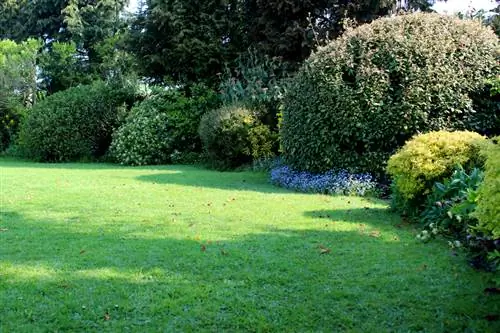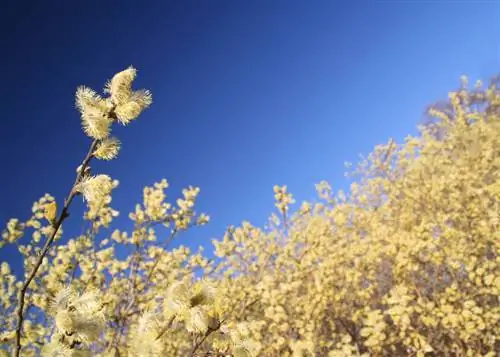- Author admin [email protected].
- Public 2023-12-16 16:46.
- Last modified 2025-01-23 11:20.
Some Elaeagnus species are well suited as hedge plants due to their uniform growth, good branching and pruning tolerance. The wintergreen olive willow is particularly suitable, as it retains its foliage at least in mild winters and therefore offers privacy all year round.

How do I plant and care for an oil willow hedge?
The wintergreen olive willow (Elaeagnus ebbingei) is ideal as a hedge plant thanks to its uniform growth, good branching and pruning tolerance. Plant 1-2 larger or 2-3 smaller olive trees per meter in spring and prune annually in June.
The wintergreen olive willow (Elaeagnus ebbingei) is a low-growing, frost-resistant ornamental tree with leaves that are dark green on the top and silvery on the underside and creamy white, intensely fragrant flowers that turn into silvery, hairy fruits. The flowering period of the wintergreen olive willow begins in September at the earliest and sometimes lasts until December.
Suitable location
The location requirements of the wintergreen olive willow are not high: it thrives in the sun or in partial shade on all cultivated soils and tolerates drought and frost equally well. In very harsh winters it can shed its leaves, but sprouts again in spring. A protected location proves to be advantageous for this Elaeagnus species.
Planting a hedge
It is recommended to plant after the last frost in spring. Previous soil enrichment with compost, for example, is not necessary. A drainage layer to protect against waterlogging is an advantage. When planting a hedge, depending on the size of the plants, you need:
- 2-3 olive trees per meter (small plants of approx. 30-40 cm) or
- 1-2 olive trees per meter (larger plants of approx. 40-60 cm).
The planting, which initially seemed a bit “loose”, soon grows together.
Hedge Care
Apart from annual pruning (in June), the hedge does not require any further care. The cut should preferably be carried out with secateurs (€14.00 on Amazon) and not with hedge trimmers. This will prevent the cut leaves from turning brown and falling off. In addition, the hedge cut in this way does not appear so strict. As with other trees, the procedure is as follows:
- shorten the excessively long shoots to promote branching,
- remove shoots growing inwards,
- cut out damaged branches.
Tip
Of the deciduous oil willow species, the coral oil willow (Elaeagnus umbellata) is well suited for hedge planting. Not only does it bloom abundantly, but it also bears a lot of fruit in our latitudes.






